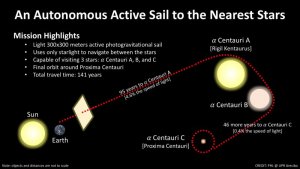Em in Ohio
Senior Member
- Location
- OH HI OH
It’s not science fiction — scientists planning mission to nearest star using tiny spacecraft by Peter Fimrite 3/14/2020
"An American starship powered by laser beams will make a rendezvous with another world within most of our lifetimes if physicists can solve a perplexing question — how to propel a craft 25 trillion miles to the nearest star fast enough for it to arrive while civilization as we know it still exists? It is a vexing problem for scientists given that a launch today, using the most powerful rockets, would take 80,000 years to reach Alpha Centauri, 4.37 light-years away."
Another approach: http://phl.upr.edu/press-releases/sailingtotheneareststars
"In April last year (2017), billionaire Yuri Milner announced the Breakthrough Starshot Initiative. He plans to invest 100 million US dollars in the development of an ultra-light light sail that can be accelerated to 20 percent of the speed of light to reach the Alpha Centauri star system within 20 years. The problem of how to slow down this projectile once it reaches its target remains a challenge. René Heller of the Max Planck Institute for Solar System Research in Göttingen and his colleague Michael Hippke propose to use the radiation and gravity of the Alpha Centauri stars to decelerate the craft. It could then even be rerouted to the red dwarf star Proxima Centauri and its potential Earth-like planet Proxima b."

"An American starship powered by laser beams will make a rendezvous with another world within most of our lifetimes if physicists can solve a perplexing question — how to propel a craft 25 trillion miles to the nearest star fast enough for it to arrive while civilization as we know it still exists? It is a vexing problem for scientists given that a launch today, using the most powerful rockets, would take 80,000 years to reach Alpha Centauri, 4.37 light-years away."
Another approach: http://phl.upr.edu/press-releases/sailingtotheneareststars
"In April last year (2017), billionaire Yuri Milner announced the Breakthrough Starshot Initiative. He plans to invest 100 million US dollars in the development of an ultra-light light sail that can be accelerated to 20 percent of the speed of light to reach the Alpha Centauri star system within 20 years. The problem of how to slow down this projectile once it reaches its target remains a challenge. René Heller of the Max Planck Institute for Solar System Research in Göttingen and his colleague Michael Hippke propose to use the radiation and gravity of the Alpha Centauri stars to decelerate the craft. It could then even be rerouted to the red dwarf star Proxima Centauri and its potential Earth-like planet Proxima b."

Last edited:


